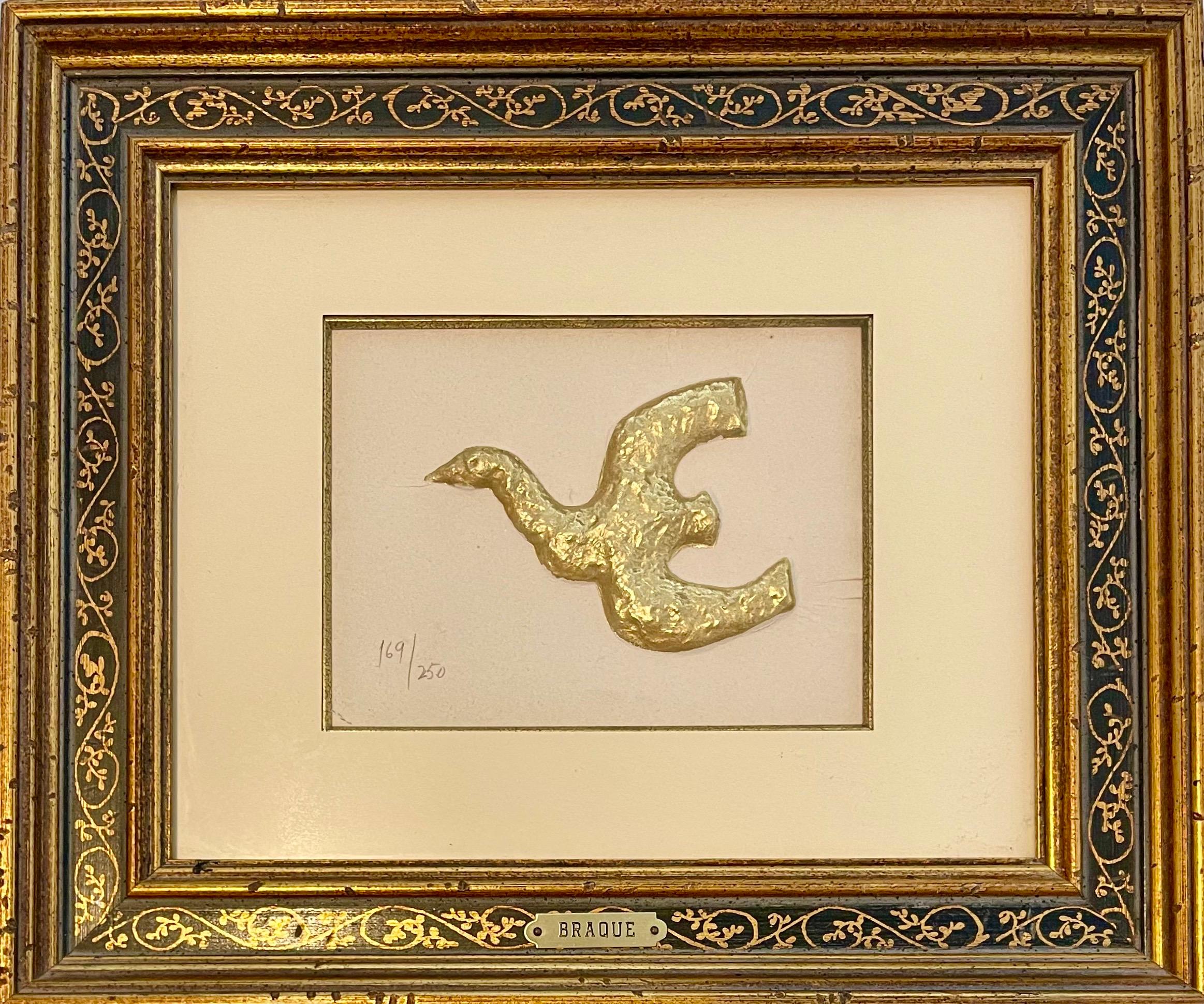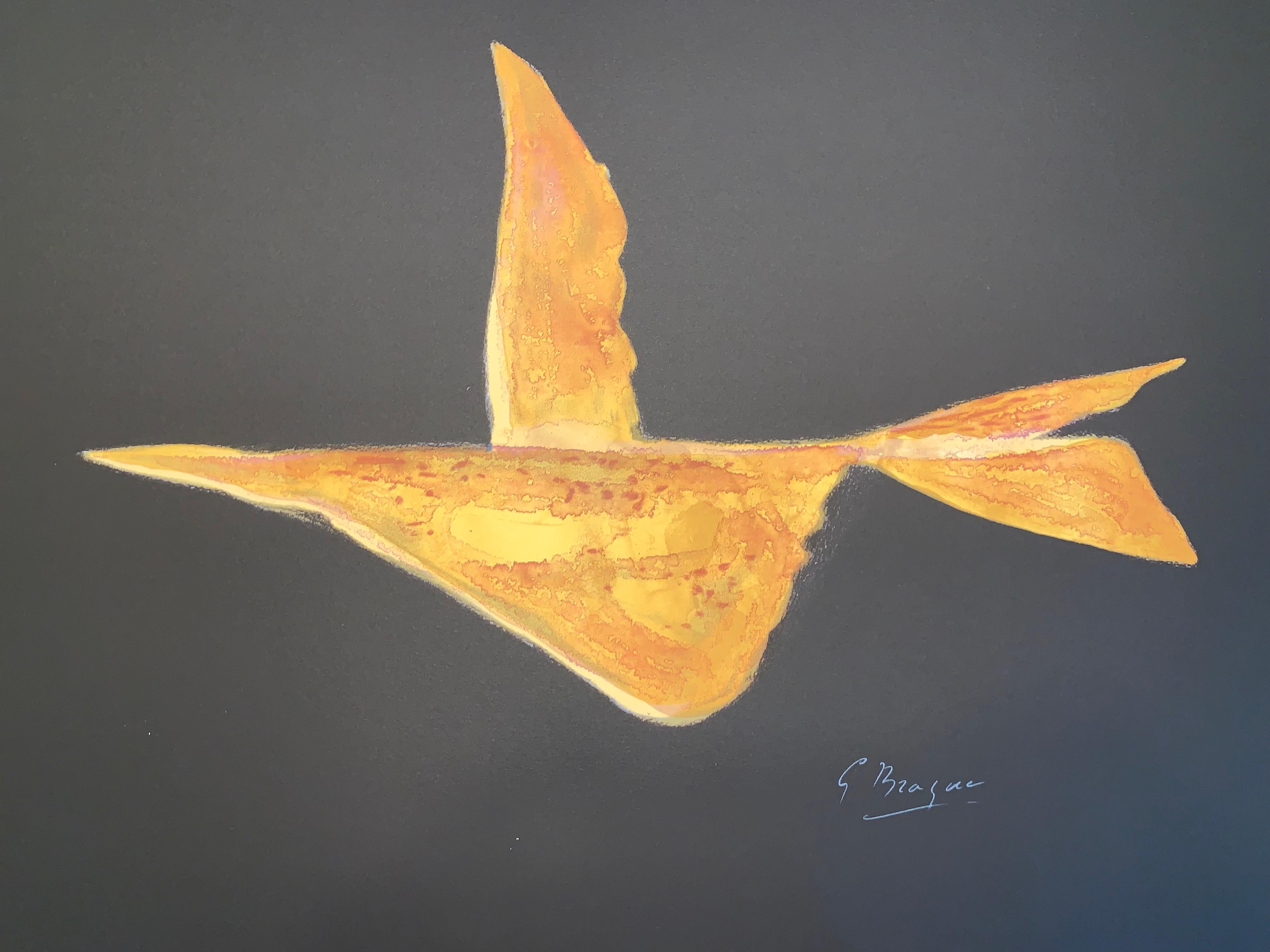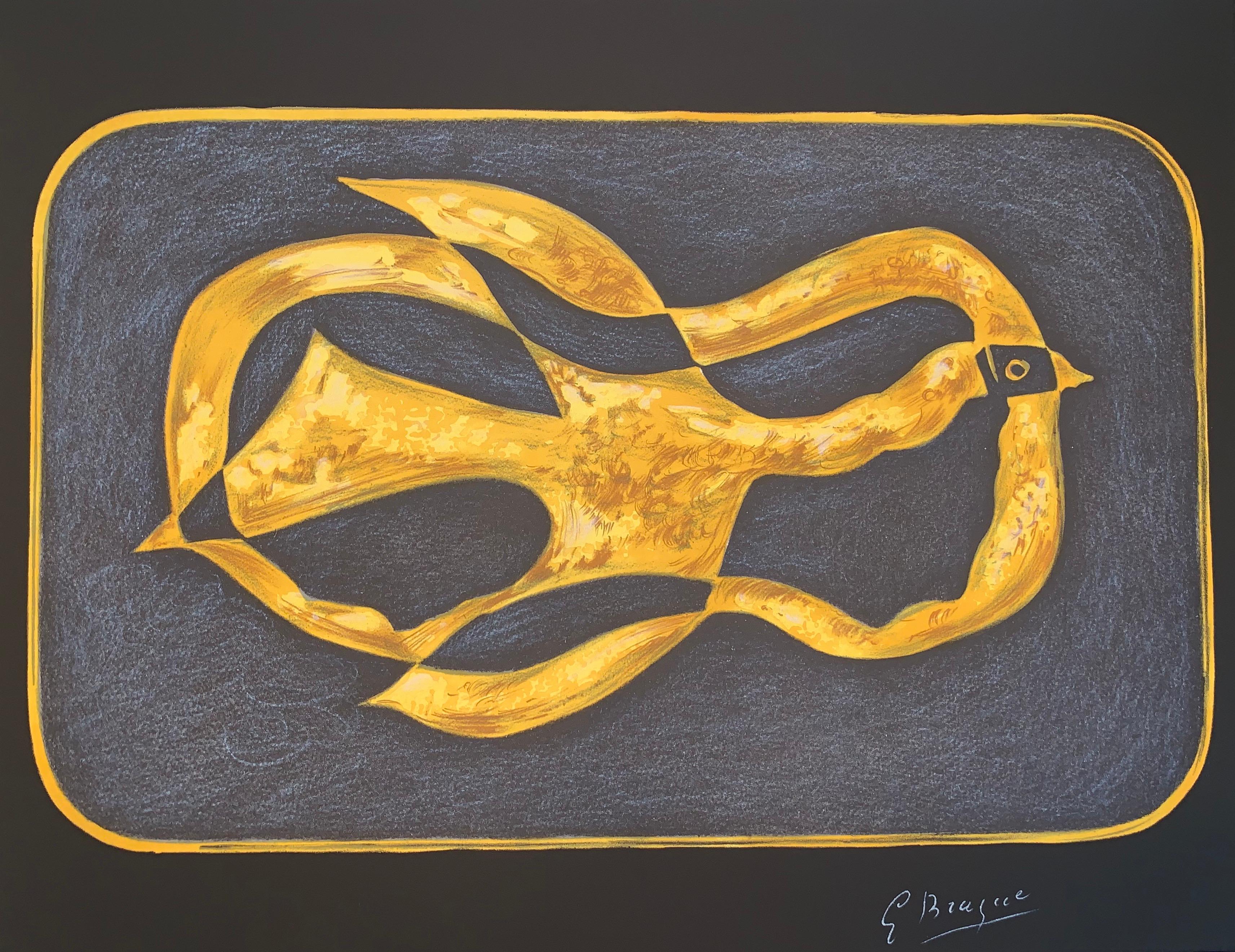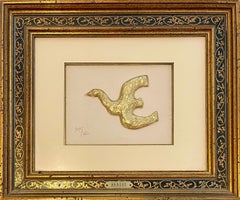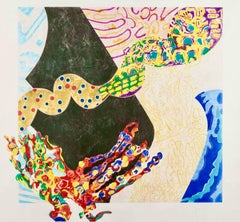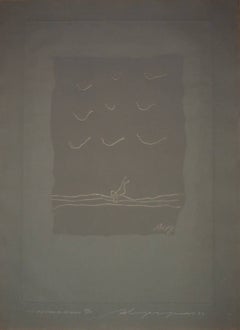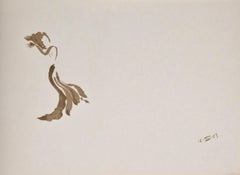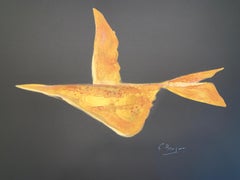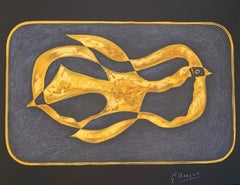Items Similar to Rare 18 Karat Gold Leaf Embossed Etching After Georges Braque L'Oiseau d'Or
Want more images or videos?
Request additional images or videos from the seller
1 of 12
Rare 18 Karat Gold Leaf Embossed Etching After Georges Braque L'Oiseau d'Or
$2,600
£1,985.63
€2,274.44
CA$3,709.06
A$4,042.54
CHF 2,105.17
MX$48,776.25
NOK 26,462.88
SEK 24,842.49
DKK 16,987.16
About the Item
Embossed print after Braque, based on his sculpture by the same name.
Embossed in the print paper is "'Cephale', Hommage aux bijoux de braque, or fin 23 carat, sculpt heger de Lowenfeld" ("tribute to Braque jewelry, 23 carat fine gold, sculpture, Heger de Lowenfeld").
The Print is signed in embossing "G. Braque" for Georges Braque.
The Work is numbered, "80/200" and hand signed "Lowenfeld" in lower left in pencil.
The Print is deeply embossed, and the bird is in gold leaf.
Sight area measures 13 1/2" x 20 1/2", while the Frame measures 23 1/2' x 30"
After Georges Braque (French, 1882-1963)
Lithograph on embossed etching paper, gilt and fine gold leaf sculpture by Georges Braque. numbered in pencil and Pencil Signed by Heger de Loewenfeld. embossed in the paper is the signature "G Braque" below image at right, also embossed in the paper is the title at bottom center; also embossed along bottom edge: "Hommage aux bijoux de BRAQUE," "OR FIN 23 CARATS," "SCULPT. HEGER DE LOWENFELD".
From the suite "Hommage aux bijoux de Braque" created to commemorate a series of Braque Jewelry, which were created in gold with enamel by the same atelier that made these embossed prints. With titles from Greek mythology. limited edition of 200. on heavy deckle edged, mould made paper.
22 x 15 in. (55.88 x 38.1 cm.).
Georges Braque was a major 20th-century French painter, collagist, draughtsman, printmaker and sculptor. His most important contributions to the history of art were in his alliance with Fauvism from 1906, and the role he played in the development of Cubism. Braque’s work between 1908 and 1912 is closely associated with that of his colleague Pablo Picasso. He grew up in Le Havre and trained to be a house painter and decorator like his father and grandfather. However, he also studied artistic painting during evenings at the École des Beaux-Arts, in Le Havre, from about 1897 to 1899. In Paris, he apprenticed with a decorator and was awarded his certificate in 1902. The next year, he attended the Académie Humbert, also in Paris, and painted there until 1904. It was here that he met Marie Laurencin and Francis Picabia.
Braque's earliest works were impressionistic, but after seeing the work exhibited by the artistic group known as the "Fauves" (Beasts) in 1905, he adopted a Fauvist style. The Fauves, a group that included Henri Matisse and André Derain among others, used brilliant colors to represent emotional response. Braque worked most closely with the artists Raoul Dufy and Othon Friesz, who shared Braque's hometown of Le Havre, to develop a somewhat more subdued Fauvist style. In 1906, Braque traveled with Friesz to L'Estaque, to Antwerp, and home to Le Havre to paint.
In May 1907, he successfully exhibited works of the Fauve style in the Salon des Indépendants. The same year, Braque's style began a slow evolution as he became influenced by Paul Cézanne who had died in 1906 and whose works were exhibited in Paris for the first time in a large-scale, museum-like retrospective in September 1907. The 1907 Cézanne retrospective at the Salon d'Automne greatly affected the avant-garde artists of Paris, resulting in the advent of Cubism.
Beginning in 1909, Braque began to work closely with Pablo Picasso who had been developing a similar proto-Cubist style of painting. At the time, Pablo Picasso was influenced by Gauguin, Cézanne, African masks and Iberian sculpture while Braque was interested mainly in developing Cézanne's ideas of multiple perspectives. During his recovery he became a close friend of the cubist artist Juan Gris. He continued to work during the remainder of his life, producing a considerable number of paintings, graphics, and sculptures. Braque, along with Matisse, is credited for introducing Pablo Picasso to Fernand Mourlot, and most of the lithographs and book illustrations he himself created during the 1940s and '50s were produced at the Mourlot Studios.
Braque died on 31 August 1963 in Paris. He is buried in the cemetery of the Church of St. Valery in Varengeville-sur-Mer, Normandy whose windows he designed. Braque's work is in most major museums throughout the world.
On 20 May 2010, the Musée d'Art Moderne de la Ville de Paris reported the overnight theft of five paintings from its collection. The paintings taken were Le pigeon aux petits pois (The Pigeon with the Peas) by Pablo Picasso, La Pastorale by Henri Matisse, L'Olivier Près de l'Estaque (Olive Tree near Estaque) by Georges Braque, La Femme à l'Éventail (fr) (Woman with a Fan) by Amedeo Modigliani and Nature Morte aux Chandeliers (Still Life with Chandeliers) by Fernand Léger and were valued at €100 million ( $123 million USD). A window had been smashed and CCTV footage showed a masked man taking the paintings. Authorities believe the thief acted alone. The man carefully removed the paintings from their frames, which he left behind. Georges Braque was a major 20th-century French painter, collagist, draughtsman, printmaker and sculptor. His most important contributions to the history of art were in his alliance with Fauvism from 1906, and the role he played in the development of Cubism. Braque’s work between 1908 and 1912 is closely associated with that of his colleague Pablo Picasso. He grew up in Le Havre and trained to be a house painter and decorator like his father and grandfather. However, he also studied artistic painting during evenings at the École des Beaux-Arts, in Le Havre, from about 1897 to 1899. In Paris, he apprenticed with a decorator and was awarded his certificate in 1902. The next year, he attended the Académie Humbert, also in Paris, and painted there until 1904. It was here that he met Marie Laurencin and Francis Picabia.
Braque's earliest works were impressionistic, but after seeing the work exhibited by the artistic group known as the "Fauves" (Beasts) in 1905, he adopted a Fauvist style. The Fauves, a group that included Henri Matisse and André Derain among others, used brilliant colors to represent emotional response. Braque worked most closely with the artists Raoul Dufy and Othon Friesz, who shared Braque's hometown of Le Havre, to develop a somewhat more subdued Fauvist style. In 1906, Braque traveled with Friesz to L'Estaque, to Antwerp, and home to Le Havre to paint. In May 1907, he successfully exhibited works of the Fauve style in the Salon des Indépendants. The same year, Braque's style began a slow evolution as he became influenced by Paul Cézanne who had died in 1906 and whose works were exhibited in Paris for the first time in a large-scale, museum-like retrospective in September 1907. The 1907 Cézanne retrospective at the Salon d'Automne greatly affected the avant-garde artists of Paris, resulting in the advent of Cubism.
Beginning in 1909, Braque began to work closely with Pablo Picasso who had been developing a similar proto-Cubist style of painting. At the time, Pablo Picasso was influenced by Gauguin, Cézanne, African masks and Iberian sculpture while Braque was interested mainly in developing Cézanne's ideas of multiple perspectives. During his recovery he became a close friend of the cubist artist Juan Gris. He continued to work during the remainder of his life, producing a considerable number of paintings, graphics, and sculptures. Braque, along with Matisse, is credited for introducing Pablo Picasso to Fernand Mourlot, and most of the lithographs and book illustrations he himself created during the 1940s and '50s were produced at the Mourlot Studios.
Braque died on 31 August 1963 in Paris. He is buried in the cemetery of the Church of St. Valery in Varengeville-sur-Mer, Normandy whose windows he designed. Braque's work is in most major museums throughout the world.
On 20 May 2010, the Musée d'Art Moderne de la Ville de Paris reported the overnight theft of five paintings from its collection. The paintings taken were Le pigeon aux petits pois (The Pigeon with the Peas) by Pablo Picasso, La Pastorale by Henri Matisse, L'Olivier Près de l'Estaque (Olive Tree near Estaque) by Georges Braque, La Femme à l'Éventail (fr) (Woman with a Fan) by Amedeo Modigliani and Nature Morte aux Chandeliers (Still Life with Chandeliers) by Fernand Léger and were valued at €100 million ( $123 million USD). A window had been smashed and CCTV footage showed a masked man taking the paintings. Authorities believe the thief acted alone. The man carefully removed the paintings from their frames, which he left behind. This is similar to the suite "Hommage aux bijoux de Braque" by Heger de Lowenfeld. Created to commemorate a series of Braque Jewelry, which were created in gold with enamel by the same atelier that made these embossed intaglio prints. With titles from Greek mythology. in 1961 Georges Braque decided with his lapidary friend Heger de Loewenfeld to pick up certain of his works to in order to create artworks. Armand and Georges Israel, publishers.
- Dimensions:Height: 23.5 in (59.69 cm)Width: 30 in (76.2 cm)
- Medium:
- Movement & Style:
- After:Georges Braque (1882 - 1963, French)
- Period:
- Condition:
- Gallery Location:Surfside, FL
- Reference Number:1stDibs: LU38211809052
About the Seller
4.9
Platinum Seller
Premium sellers with a 4.7+ rating and 24-hour response times
Established in 1995
1stDibs seller since 2014
1,822 sales on 1stDibs
Typical response time: 1 hour
- ShippingRetrieving quote...Shipping from: Surfside, FL
- Return Policy
Authenticity Guarantee
In the unlikely event there’s an issue with an item’s authenticity, contact us within 1 year for a full refund. DetailsMoney-Back Guarantee
If your item is not as described, is damaged in transit, or does not arrive, contact us within 7 days for a full refund. Details24-Hour Cancellation
You have a 24-hour grace period in which to reconsider your purchase, with no questions asked.Vetted Professional Sellers
Our world-class sellers must adhere to strict standards for service and quality, maintaining the integrity of our listings.Price-Match Guarantee
If you find that a seller listed the same item for a lower price elsewhere, we’ll match it.Trusted Global Delivery
Our best-in-class carrier network provides specialized shipping options worldwide, including custom delivery.More From This Seller
View AllRare 18 Karat Gold Leaf Embossed Etching After Georges Braque L'Oiseau d'Or
By Georges Braque
Located in Surfside, FL
After Georges Braque (French, 1882-1963)
"L'Oiseau d'Or," embossed cast-paper intaglio with 18K gold paint after Braque's Oiseau brooch design, unsigned, edition number 169/250,
Siz...
Category
20th Century Modern Figurative Prints
Materials
Gold Leaf
Large Nancy Graves Color Aquatint Drypoint Etching Screenprint Metallic Gold
By Nancy Graves
Located in Surfside, FL
Nancy Graves, American (1939-1995)
Borborygmi (1988)
aquatint, drypoint, gold leaf and screenprint on Fabriano Artistico paper
pencil hand signed by artist lower right, numbered 4/50 (there were also 6 Artist Proofs of this edition)
plate: 49.5 x 49.5 inches
Publisher: 2RC Edizioni d'Arte, Rome
Nancy Graves (December 23, 1939 – October 21, 1995) was an American woman sculptor, painter, printmaker, and sometime-filmmaker known for her focus on natural phenomena like camels or maps of the moon. Her works are included in many public collections, including those of the National Gallery of Art (Washington, D.C.), the Brooklyn Museum of Art, the Smithsonian American Art Museum, the National Gallery of Australia (Canberra), Walker Art Center (Minneapolis), and the Museum of Fine Arts (St. Petersburg). When Graves was just 29, she was given a solo exhibition at the Whitney Museum of American Art. At the time she was the youngest artist, and fifth woman to achieve this honor.
Graves was born in Pittsfield, Massachusetts. Her interest in art, nature, and anthropology was fostered by her father, an accountant at a local museum. After graduating from Vassar College in English Literature, Graves attended Yale University, where she received her bachelor's and master's degrees. Fellow Yale Art and Architecture alumni of the 1960s include the painters, photographers, and sculptors Brice Marden, Richard Serra, Chuck Close, Janet Fish, Gary Hudson...
Category
1980s Contemporary Abstract Prints
Materials
Screen
Latvian Modernist 'The Sky Hides All It's Birds' Intaglio Etching Embossing
By Adja Yunkers
Located in Surfside, FL
Printed on Dark Paper a magnificent piece. this is an etching with embossing
on black wove, J Barcham Green paper
Publisher Styria Studio, chopmark lower left
Adja Yunkers
b. 1900...
Category
1970s Modern Animal Prints
Materials
Etching
Apeles Fenosa Spanish Sculptor Mourlot Lithograph Abstract Expressionist Figures
By Apelles Fenosa
Located in Surfside, FL
This is from a hand signed, limited edition (edition of 125) folio or full page lithographs some having a poem verso. The individual sheets are not signed or numbered. This listing ...
Category
1970s Expressionist Figurative Prints
Materials
Lithograph
Canada Suite Signed Serigraph Birds
By Yargo De Lucca
Located in Surfside, FL
Original serigraph silkscreen prints by German/Canadian expressionist
Yargo de Lucca (1925-2008) from the “Canada Suite” series, a
hand-signed and numbered Inuit-inspired silkscreen...
Category
20th Century Animal Prints
Materials
Lithograph
Rare Israeli Surrealist Judaica Abstract Lithograph Naftali Bezem
By Naftali Bezem
Located in Surfside, FL
Fine lithograph on deckle edged French Arches paper. Pencil signed and numbered from edition of 150.
A Surrealist Judaica scene of a bearded man (Rabbi) in a boat with Shabbat candlesticks. with blindstamp from Editions Empreinte in Paris, France. (They published, Jean Michel Folon, Sempe, Raoul Ubac, Raymond Savignac, Cesar, Bengt Lindstrom , Paul Aizpiri and many other modern masters.
Naftali Bezem (Hebrew: נפתלי בזם; born November 27, 1924) is an Israeli painter, muralist, and sculptor.
Bezem was born in Essen, Germany, in 1924. His early adolescence was spent under Nazi oppression, in constant fear for the safety of his parents, who perished in the Holocaust in the Polish Auschwitz concentration camp. Naftali emigrated to Mandate Palestine in 1939, at the age of fourteen with a Youth Aliyah group.
From 1943 to 1946, he studied art at the Bezalel Academy of Art and Design in Jerusalem with Israeli painter Mordecai Ardon. He then spent three years studying in Paris.His most famous public works include a wall relief at Yad Vashem in Jerusalem and the ceiling mural in the main reception room at the President's Residence, Jerusalem.In 1957, Bezem was a co-recipient of the Dizengoff Prize for Painting.
Group Exhibitions
Orit Art Gallery, Tel Aviv
Artists: Yosef Zaritsky, Marcel Janco, Lea Nikel, Robert Baser, Bezem, Michael Druks,
Israeli Painting (Watercolors and Gouache)
Artists:
Pinchas Abramovich, Bezem, Naftali Nachum Gutman, Haim Gliksberg, Mordechai Levanon, Avigdor Stematsky, Avshalom Okashi, Yehiel Krize...
Category
20th Century Modern Figurative Prints
Materials
Lithograph
You May Also Like
Elegant flight - Lithograph - Printed signature
By (after) Georges Braque
Located in Paris, IDF
George BRAQUE
Elegant flight
Lithograph on vellum after a painting
Printed signature in the plate
399 copies unnumbered
On Arches vellum 18 x 23" (45 x 58 cm)
Excellent condition
Category
Late 20th Century Cubist Animal Prints
Materials
Lithograph
Leda and the Swann - lithograph - 399 copies
By (after) Georges Braque
Located in Paris, IDF
Georges BRAQUE
Leda and the Swann
Stone lithograph (Art-Litho workshop, Paris)
Printed signature in the pate
Limited to 399 copies unumbered
On Arches vellum 18 x 23" (45 x 58 cm)
E...
Category
Late 20th Century Cubist Animal Prints
Materials
Lithograph
Phaeton - after Georges Braque - Lithograph - 1988 - Figurative Print
By (after) Georges Braque
Located in Sint-Truiden, BE
Color lithograph after a gouache by Georges Braque from the edition of 398 published by Armand & Georges Israel in 1988. Printed signature.
Artwork en...
Category
1980s Cubist Figurative Prints
Materials
Lithograph
Boréade - after Georges Braque - Lithograph - 1988 - Figurative Print
By (after) Georges Braque
Located in Sint-Truiden, BE
Color lithograph after a gouache by Georges Braque from the edition of 398 published by Armand & Georges Israel in 1988. Printed signature.
Artwork en...
Category
1980s Cubist Figurative Prints
Materials
Lithograph
"L'oiseau de sables (Bird of the Sands)" contemporary animal bright signed
By Georges Braque
Located in Milwaukee, WI
"L'oiseau de sables" ("Bird of the Sands") is an original signed lithograph by Georges Braque executed in 1962. It is 37 of an edition of 125. The work is one of five lithographs cre...
Category
1960s Fauvist Animal Prints
Materials
Printer's Ink, Lithograph
After Georges Braque - Antiborée - Lithograph
Located in Collonge Bellerive, Geneve, CH
Lithograph after Georges Braque.
Signed in the plate
Edition of 150
Dimensions: 76 x 117 cm
Bibliography:
« Les Métamorphoses de Braque» of Heger de Loewenfeld and Raphaël de Cuttoli , Editions FAC, Paris, 1989.
In 1961 Georges Braque decided with his laidary friend Heger de Loewenfeld to pick up certain of his works to in order to create artworks, this beautiful litograph is one of them.
Héméra in the Mythology:
In Greek mythology Hemera was the personification of day and one of the Greek primordial deities. She is the goddess of the daytime and, according to Hesiod, the daughter of Erebus and Nyx (the goddess of night). Hemera is remarked upon in Cicero's De Natura Deorum, where it is logically determined that Dies (Hemera) must be a god, if Uranus is a god. The poet Bacchylides states that Nyx and Chronos are the parents, but Hyginus in his preface to the Fabulae mentions Chaos as the mother/father and Nyx as her sister.
She was the female counterpart of her brother and consort, Aether (Light), but neither of them figured actively in myth or cult. Hyginus lists their children as Uranus, Gaia, and Thalassa (the primordial sea goddess), while Hesiod only lists Thalassa as their child.
The father of Cubism
Three Cubist that distinguishes art historian periods were initiated and developed by Georges Braque: The Cubist Cézanne (1907-1909), Executive (1909-1912) and synthetic (1912-1922).
Post-Impressionist and fawn, Braque no longer adheres to the contingency of a decorative way or the other. Cézanne’s paintings exhibited at the Grand Palais during the retrospective of 1907 are a revelation: Cézanne sought and invented a pictorial language. In his footsteps, Braque went to the South with the reasons of the Master. He returned with Estaque landscapes and surprising Ciotat it keeps Cezanne geometric model and retains the “passages” continuity from one surface to another to create the sensation of “turning around” of the object represented. But he wants to go after the consequences of the vision of Cezanne. In his paintings Houses in L’Estaque (1908) it simplifies the volumes of houses, neglects detail by removing doors and windows: the plastic rhythm that builds the table. Large Nude , a masterpiece of the period, can be considered the first work of Cézanne cubism .
Systematizing and deepening Braque discoveries open the door analytical cubism. In 1909, his painting became more cerebral than sensual. The pattern is recreated in the two-dimensionality of the canvas, leaving aside any illusionistic perspective. In Still Life with Violin, objects are analyzed facets according to their characteristic elements, each facet referring to a particular view of the object. There are so many facets of points selected view: Table reflects the knowledge of the object and the ubiquity of the eye. Moreover, Braque is looking for the essence of the objects in the world rather than their contingency, which explains the absence of light source and use of muted colors (gray, ocher), contingent aspects of the object . But formal logic has stepped facets, erased any anecdote to the object and ultimately led to his painting a hermetic more marked on the edge of abstraction (see the series of Castle Roche-Guyon ).
Braque, anxious to keep the concrete and refusing at all costs that the logic of Cubism takes the paintings to abstract, reintroduced signs of reality in his paintings in 1912 marks the beginning of Synthetic Cubism. Historians speak of “signs of real” rather than reality because what interests Braque, this is not to put reality into a table, but to create a painting which, by its language, refers to the real. To do this, he invented two major techniques XX th century inclusions and contributions. The inclusions consist of painting objects that have no real depth, materials (wallpaper in Nature morte aux playing cards faux wood is a pictorial inclusion) or letters (calligraphic inclusion in Portuguese ), made first brush and a few months later stencil. Contributions are defined in contrast with the collage on canvas of foreign materials: glued or sand paper, sawdust, etc.. Regarding the collages, Braque used for the first time in September 1912 a piece of adhesive paper imitating faux wood Compote...
Category
1950s Cubist Animal Prints
Materials
Lithograph
More Ways To Browse
Georges Braque Gold
Heger De Loewenfeld
Georges Braque 1961
Vintage Aquarius Art
Woman In Boat
180 Dessins De Picasso
1940s Framed Japanese Silk Paintings
Al Hirschfeld Hollywood
Bob Dylan Poster
Bob Dylan Posters Vintage
Chagall Unsigned
Chapeau Pierre
Dali Changes In Great Masterpieces
Dali Horse
Dance Of Death
Dean Mitchell
Edgar Degas Lithograph
Framed Wpa Prints
